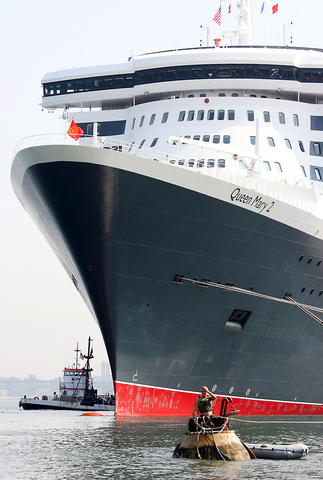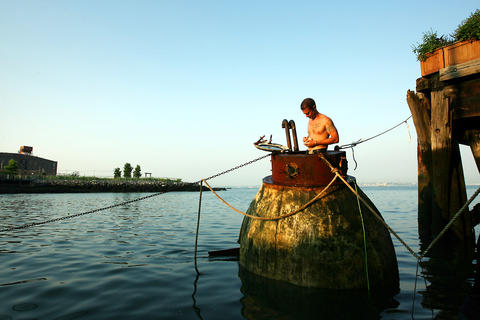At slack tide off Red Hook, Brooklyn, there are usually lots of things floating in the water, most of which you would not want to touch without the help of a good hazmat suit. But just after sunrise Friday, something truly strange was bobbing there in the shallows near Pier 41: a submarine fashioned almost completely from wood, and inside it a man with an obsession.
The man, Duke Riley, a heavily tattooed Brooklyn artist whose waterborne performance projects around New York have frequently landed him in trouble with the authorities, spent the last five months building the vessel as a rough replica of what is believed to have been America's first submarine, an oak sphere called the Turtle, which saw action in New York Harbor during the Revolutionary War.
Riley's plan was also military, in a sense - though mostly metaphorical, given that he is an artist. He wanted to float north in the Buttermilk Channel to stage an incursion against the Queen Mary 2, which had just docked in Red Hook, the mission objective mostly just to get close enough to the ship to videotape himself against its immensity for an upcoming gallery show.

PHOTOS: NY TIMES NEWS SERVICE
But when his sub was stopped by a New York City police boat around 10am, the outcome was not metaphorical at all: Riley, 35, and two friends who had helped tow him were taken into custody by a phalanx of law enforcement officials, and their excursion briefly raised fears that a terrorist attack might have been under way.
The flurry of attention that followed, on television and untold numbers of urban blogs, generated the kind of publicity that most artists would pay good money for.
Police Commissioner Raymond Kelly issued a statement later calling the incident "marine mischief" - the "creative craft of three adventuresome individuals" - and saying nothing suspicious had been recovered "other than the vessel itself." He played down the possibility that the cruise ship could have been endangered had the intent been more malicious than artful, suggesting that the sub had been detected in plenty of time.

Kelly said a New York police detective assigned to the department's intelligence division who was aboard the Queen Mary 2 Friday morning first spotted what looked like a hobby-shop submarine towed by a flimsy rubber raft manned by Riley's two friends. He called the department's harbor patrol, which dispatched three boats to the scene along with a helicopter, joined later by the Coast Guard and a hazardous-materials truck.
Still, Riley, who emerged from his rusty hatch without the tall-boy can of beer he had taken into his vessel when it launched about 9:15am, managed to make it to within about 61m of the bow of the ship, at a time when officials say harbor security is a critical factor in guarding against terrorism. From a nearby pier, several of his friends and his art dealers shouted congratulations through a chain-link fence.
But the police impounded the sub, and the Coast Guard issued Riley a citation for violating the ship's 91m security zone. The police issued two more, for unsafe boating. (Riley had no means of propulsion and was relying mainly on the kindness of the incoming tide to take him toward his objective.)
In an interview at Pier 41 on Thursday afternoon, after Riley called a reporter to alert him to the planned excursion, the artist said he first became interested in building the submarine after reading about the Turtle in history books. (By some accounts, the original submarine's attempt to attach an explosive to the bottom of a British warship failed, but the device detonated near the ship and caused the British to move their vessels. Other accounts say the sub never even launched.)
Riley built his 2.4m-tall submersible not from oak but from cheap plywood, coated with fiberglass and topped off with portholes and a hatch bought from a marine salvage company. Pumps in the bottom allowed him to add water for ballast or remove it.
On Thursday evening, he and the two friends, Jesse Bushnell and Mike Cushing, scrambled around in the murky Red Hook water - avoiding the occasional condom or dead rat - to make sure that the sub, called the Acorn, was seaworthy and would submerge. (It never did so completely.). They had loaded several thousand pounds of lead into the bottom and were adding rocks to further lower the moss-coated vessel, which resembled something out of Jules Verne by way of Huck Finn, manned by cast members from Jackass.
"We start arguing with each other and saying, 'Hey, you're doing that wrong,'" said Bushnell, who owns a bicycle shop in Providence, Rhode Island. "And then we realize there is no right way to do this." He added grumpily, "I've basically been wading around in this water for three days in my underwear."
Riley's last big artwork was an illegal makeshift tavern built last summer on a spit of land near Rockaway Inlet in Queens that in the early 1900s was a kind of Wild West territory, with saloons and prizefights. That project was also brought to a premature end by the police, who arrived at night with guard dogs and scattered most of Riley's friends. With the submarine, which he launched on a short-lived test run to the Queen Mary 2 last month, Riley said he accepted early on that the real performance would probably end with an arrest. Or with him sinking.
"I'm not really a very technical kind of guy," he said, sitting shirtless on the pier Thursday with various green things still clinging to his arms from the water. "I just guessed a lot on this." Asked how he planned to get back to shore after the tide carried him out to the cruise ship, he grinned. "I haven't really thought about that yet," he said.
On Friday afternoon, as he, Bushnell and Cushing were being taken into custody, still dripping wet, Riley's art dealers, Alberto Magnan and Dara Metz, said they planned to display the submarine in a show soon at their Chelsea gallery. And to post Riley's bail, if needed. "My wife's cousin is a lawyer," Magnan said.
As he spoke, one of the beefy police officers standing on the bow of a harbor patrol boat laughed and, pointing at the wooden submarine below him, said: "What are we going to do with this thing? It looks like the Turtle!"

May 18 to May 24 Pastor Yang Hsu’s (楊煦) congregation was shocked upon seeing the land he chose to build his orphanage. It was surrounded by mountains on three sides, and the only way to access it was to cross a river by foot. The soil was poor due to runoff, and large rocks strewn across the plot prevented much from growing. In addition, there was no running water or electricity. But it was all Yang could afford. He and his Indigenous Atayal wife Lin Feng-ying (林鳳英) had already been caring for 24 orphans in their home, and they were in

On May 2, Chinese Nationalist Party (KMT) Chairman Eric Chu (朱立倫), at a meeting in support of Taipei city councilors at party headquarters, compared President William Lai (賴清德) to Hitler. Chu claimed that unlike any other democracy worldwide in history, no other leader was rooting out opposing parties like Lai and the Democratic Progressive Party (DPP). That his statements are wildly inaccurate was not the point. It was a rallying cry, not a history lesson. This was intentional to provoke the international diplomatic community into a response, which was promptly provided. Both the German and Israeli offices issued statements on Facebook

President William Lai (賴清德) yesterday delivered an address marking the first anniversary of his presidency. In the speech, Lai affirmed Taiwan’s global role in technology, trade and security. He announced economic and national security initiatives, and emphasized democratic values and cross-party cooperation. The following is the full text of his speech: Yesterday, outside of Beida Elementary School in New Taipei City’s Sanxia District (三峽), there was a major traffic accident that, sadly, claimed several lives and resulted in multiple injuries. The Executive Yuan immediately formed a task force, and last night I personally visited the victims in hospital. Central government agencies and the

Australia’s ABC last week published a piece on the recall campaign. The article emphasized the divisions in Taiwanese society and blamed the recall for worsening them. It quotes a supporter of the Taiwan People’s Party (TPP) as saying “I’m 43 years old, born and raised here, and I’ve never seen the country this divided in my entire life.” Apparently, as an adult, she slept through the post-election violence in 2000 and 2004 by the Chinese Nationalist Party (KMT), the veiled coup threats by the military when Chen Shui-bian (陳水扁) became president, the 2006 Red Shirt protests against him ginned up by